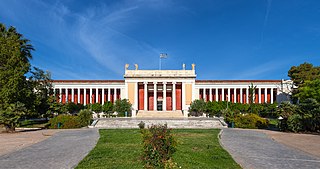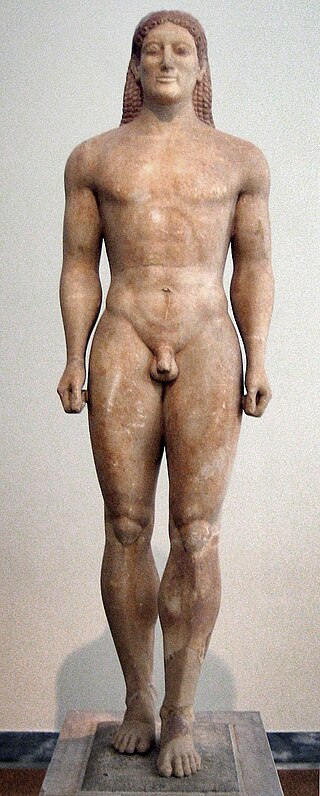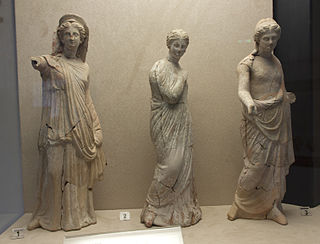
Art theft, sometimes called artnapping, is the stealing of paintings, sculptures, or other forms of visual art from galleries, museums or other public and private locations. Stolen art is often resold or used by criminals as collateral to secure loans. Only a small percentage of stolen art is recovered—an estimated 10%. Many nations operate police squads to investigate art theft and illegal trade in stolen art and antiquities.

The J. Paul Getty Museum, commonly referred to as the Getty, is an art museum in Los Angeles, California housed on two campuses: the Getty Center and Getty Villa. It is operated by the J. Paul Getty Trust, the world's wealthiest art institution.

The sculpture of ancient Greece is the main surviving type of fine ancient Greek art as, with the exception of painted ancient Greek pottery, almost no ancient Greek painting survives. Modern scholarship identifies three major stages in monumental sculpture in bronze and stone: the Archaic, Classical (480–323) and Hellenistic. At all periods there were great numbers of Greek terracotta figurines and small sculptures in metal and other materials.

Morgantina is an archaeological site in east central Sicily, southern Italy. It is sixty kilometres from the coast of the Ionian Sea, in the province of Enna. The closest modern town is Aidone, two kilometres southwest of the site. The site consists of a two-kilometre-long ridge running southwest-northeast, known as Serra Orlando, and a neighbouring hill at the northeast called Cittadella. Morgantina was inhabited in several periods. The earliest major settlement was made at Cittadella and lasted from about 1000/900 to about 450 BCE. The other major settlement was located on Serra Orlando, and existed from about 450 BCE to about 50 CE in Magna Graecia. Morgantina has been the subject of archaeological investigation since the early 20th century.

The National Archaeological Museum in Athens houses some of the most important artifacts from a variety of archaeological locations around Greece from prehistory to late antiquity. It is considered one of the greatest museums in the world and contains the richest collection of Greek Antiquity artifacts worldwide. It is situated in the Exarcheia area in central Athens between Epirus Street, Bouboulinas Street and Tositsas Street while its entrance is on the Patission Street adjacent to the historical building of the Athens Polytechnic university.

The Getty Villa is an educational center and art museum located at the easterly end of the Malibu coast in the Pacific Palisades neighborhood of Los Angeles, California, United States. One of two campuses of the J. Paul Getty Museum, the Getty Villa is dedicated to the study of the arts and cultures of ancient Greece, Rome, and Etruria. The collection has 44,000 Greek, Roman, and Etruscan antiquities dating from 6,500 BC to 400 AD, including the Lansdowne Heracles and the Victorious Youth. The UCLA/Getty Master's Program in Archaeological and Ethnographic Conservation is housed on this campus.

Repatriation is the return of the cultural property, often referring to ancient or looted art, to their country of origin or former owners.
Robert Emmanuel Hecht, Jr. was an American antiquities art dealer based in Paris.
Cornelius Clarkson Vermeule III was an American scholar of ancient art and curator of classical art at the Museum of Fine Arts, Boston, from 1957 to 1996. He was also well known as a numismatist. He also used the pseudonyms Wentworth Bunsen, Isao Tsukinabe and Northwold Nuffler.

The Kroisos Kouros is a marble kouros from Anavyssos (Ανάβυσσος) in Attica which functioned as a grave marker for a fallen young warrior named Kroisos (Κροῖσος).

Looted art has been a consequence of looting during war, natural disaster and riot for centuries. Looting of art, archaeology and other cultural property may be an opportunistic criminal act or may be a more organized case of unlawful or unethical pillage by the victor of a conflict. The term "looted art" reflects bias, and whether particular art has been taken legally or illegally is often the subject of conflicting laws and subjective interpretations of governments and people; use of the term "looted art" in reference to a particular art object implies that the art was taken illegally.

The Victorious Youth, Getty Bronze, also known as Atleta di Fano, or Lisippo di Fano, is a Greek bronze sculpture, made between 300 and 100 BC, in the collections of the J. Paul Getty Museum, Pacific Palisades, California. Many underwater bronzes have been discovered along the Aegean and Mediterranean coast; in 1900 sponge divers found the Antikythera Youth and the portrait head of a Stoic, at Antikythera, the standing Poseidon of Cape Artemision in 1926, the Croatian Apoxyomenos in 1996 and various bronzes until 1999. The Victorious Youth was found in the summer of 1964 in the sea off Fano on the Adriatic coast of Italy, snagged in the nets of an Italian fishing trawler. In the summer of 1977, The J. Paul Getty Museum purchased the bronze statue and it remains in the Getty Villa in Malibu, California. Bernard Ashmole, an archaeologist and art historian, was asked to inspect the sculpture by a Munich art dealer Heinz Herzer; he and other scholars attributed it to Lysippos, a prolific sculptor of Classical Greek art. The research and conservation of the Victorious Youth dates from the 1980s to the 1990s, and is based on studies in classical bronzes, and ancient Mediterranean specialists collaboration with the Getty Museum. The entire sculpture was cast in one piece; this casting technique is called the "lost wax" method; the sculpture was first created in clay with support to allow hot air to melt the wax creating a mold for molten bronze to be poured into, making a large bronze Victorious Youth. More recently, scholars have been more concerned with the original social context, such as where the sculpture was made, for what context and who he might be. Multiple interpretations of where the Youth was made and who the Youth is, are expressed in scholarly books by Jiri Frel, Paul Getty Museum curator, from 1973 to 1986, and Carol Mattusch, Professor of Art History at George Mason University specializing in Greek and Roman art with a focus in classical bronzes.
Giacomo Medici is an Italian antiquities smuggler and art dealer who was convicted in 2004 of dealing in stolen ancient artifacts. His operation was thought to be "one of the largest and most sophisticated antiquities networks in the world, responsible for illegally digging up and spiriting away thousands of top-drawer pieces and passing them on to the most elite end of the international art market".
Robin Symes was a British antiquities dealer who was unmasked as a key player in an international criminal network that traded in looted archaeological treasures. Symes and his long-term partner Christo Michaelides met and formed a business partnership in the 1970s, and Symes became one of Britain's most prominent and successful antiquities dealers. However, after Michaelides died accidentally in 1999, his family took legal action to recover his share of the Symes company's assets, and when the matter went to trial, Symes was found to have lied in his evidence about the extent and value of his property; he was subsequently charged with and convicted of contempt of court, and sentenced to two years' imprisonment, of which he served seven months. Further investigations by Italian authorities revealed in January 2016 that Symes's involvement in the illegal antiquities trade had been even more extensive than previously thought, and that he had hidden a vast hoard of looted antiquities in 45 crates at the Geneva Freeport storage warehouse in Switzerland for 15 years to conceal them from Michaelides's family.
The Hera Borghese is a type of sculpture of Hera named after the owners of its archetype, the Borghese family.
The antiquities trade is the exchange of antiquities and archaeological artifacts from around the world. This trade may be illicit or completely legal. The legal antiquities trade abides by national regulations, allowing for extraction of artifacts for scientific study whilst maintaining archaeological and anthropological context. The illicit antiquities trade involves non-scientific extraction that ignores the archaeological and anthropological context from the artifacts.

The Getty kouros is an over-life-sized statue in the form of a late archaic Greek kouros. The dolomitic marble sculpture was bought by the J. Paul Getty Museum, Los Angeles, California, in 1985 for ten million dollars and first exhibited there in October 1986.
Jiří Frel was a Czech and American archaeologist. Between 1973 and 1986 he served as a curator for the J. Paul Getty Museum. He is credited with the expansion of the collection of antiquities of the museum, but he was also involved in a number of controversies, including a tax manipulation scheme to buy artifacts of dubious provenance and purchase of a number of artifacts widely considered to be fake.

The Archaeological Museum of Aidone is a regional museum in Aidone in the province of Enna, Sicily. It is housed in a former Capuchin convent dedicated to Saint Francis. It was inaugurated in the summer of 1984 and preserves the findings of over thirty years of excavations in Morgantina, ordered according to chronological and thematic criteria.
Nancy Wiener is an antiquities dealer who pleaded guilty to charges of conspiracy and possession of stolen property












